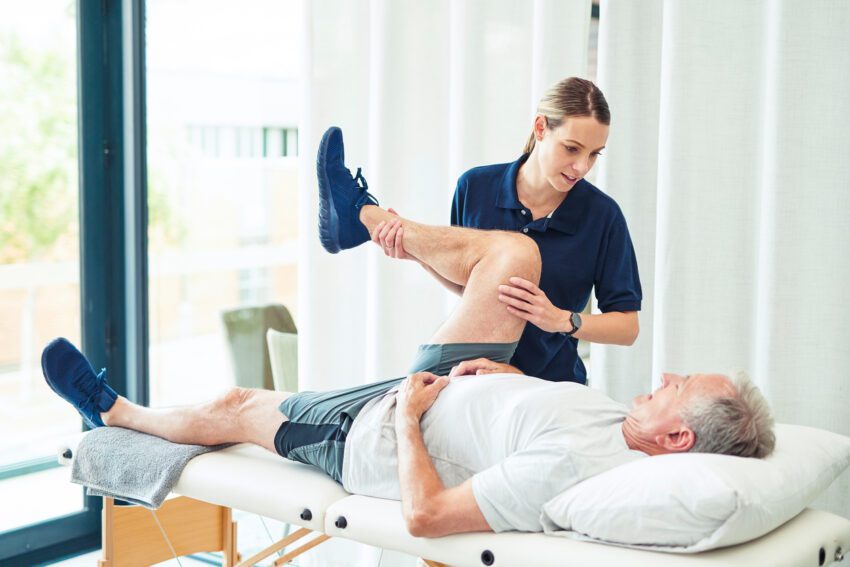As a chiropractor, I commonly see people with complaints of neck and back pain. Usually I’ll take a set of x-rays to assess what their spine looks like, and sadly, I often have to tell them that they have some degree of spinal degeneration. Spinal degeneration presents as thinning of the cartilaginous disc between the vertebrae (called “degenerative disc disease”) as well as the formation of osteophytes, or bone spurs, along the edges of the bones. This process can occur at any joint but is particularly troublesome in the spine, due to all of the neurological structures it can interfere with. While we don’t want degeneration anywhere in our bodies, joints like hips, knees, and shoulders can be replaced, if necessary. However, we only get one spine so we must take extra care of it throughout our lives.
The spine consists of 24 vertebral bones (plus the sacrum and coccyx) connected by 48 separate “facet” joints. These are the joints where Degenerative Joint Disease (DJD) is most commonly found. DJD is a gradual process that involves the wearing down of structures that make up a joint. This can happen anywhere in the skeletal system that has suffered a trauma or undergone too much “wear and tear.” This is why it will be frequently be found on one side of the body. For instance, if someone tends to put more weight on their right leg, the right hip and knee will likely degenerate faster. This is unlike an inflammatory joint disease, like Rheumatoid Arthritis (RA), that will occur on both sides of the body to multiple joints.
While conditions like RA tend to be genetically inherited, structural degeneration can happen to anyone, which is why it’s the leading cause of joint pain in adults. Since DJD tends to get worse as people age, it is generally thought that this is just a normal aging process. However, after learning about joint structure and function through school, research, and clinical experiences, I believe that aging is more correlated than causative, and that to an extent, degeneration is common but not normal.
When told “getting old” is to blame, people are dis-empowered. After all, we can’t do anything about aging. As a practitioner who mainly works with joints, hearing that they get unhealthy because of aging is like telling a dentist that people get cavities due to old age. Of course there are some genetic conditions that cause people to have weaker joint structures. Certain things truly are out of our control, such as the fact that the more years we live, the more likely our joints will be subjected to stressors and wear. Yet there are some things we can do to keep our joints healthier. Here are 5 things you can do to defy aging and keep your joints young!
1) Move More Often
This may seem like an obvious thing to do, after all, staying active is a vital part of most health advice. Yet if we specifically consider the structure and physiology of joints, we can better appreciate how important movement is.
Joints are where bones connect and allow our skeletal structure to move. In the body, there are three types of joints: fibrous (non-moveable), cartilaginous (slightly moveable), and synovial (freely moveable). The spine is composed of vertebral bones connected by discs (cartilaginous joints) and facets (synovial joints). The synovial “facet” joints are what allow our spines to bend and twist, while the cartilaginous discs provide stability and cushioning from impact and gravity. Each spinal facet joint is encased by a fibrous capsule lined with a membrane called “synovium” that produces “synovial fluid.” This fluid lubricates the joint and reduces friction between the articular cartilage, which lines the bone. It also supplies oxygen and nutrients and removes carbon dioxide and metabolic waste. Just like the oil in a car engine, this fluid needs to be routinely replenished. To ensure this, within the articular cartilage there is a reserve of synovial fluid that gets mechanically squeezed out during movement. This is why it is so important to move! Moving joints in their full range of motion is the most effective way to get fresh synovial fluid.
To use a quote I heard in a yoga class, “Movement is life, and motion is like lotion.” Speaking of yoga, I often recommend to patients that they begin a yoga practice. Certainly any consistent stretching routine will be of great benefit, but in my experience, yoga is one of the most effective ways to move and stretch the entire body. It also helps improve one’s body awareness so that imbalances can be found. Like I tell my patients, yoga and stretching are like brushing and flossing, and I’m like the dentist. If they don’t want to see me as often, get brushing!
2) See a musculoskeletal specialist, such as a chiropractor, physical therapist or orthopedist, to assess your spinal joint movement.
With an understanding of joint structure and movement, we now have to consider the fact that some of our joints may become restricted or stuck over time. These restrictions can be due to trauma, such as a car accident or sporting injury, or to consistent microtraumas, like sleeping in an odd position every night or constantly looking down at smart phone devices. Even emotional and chemical stressors can contribute to loss of mobility by increasing tension in the body. While these joint restrictions may be quite small, they can lead to very big problems over time.
In a 2004 study from the Journal of Manipulative and Physiological Therapeutics, researchers studied “Degenerative Changes Following Spinal Fixation in a Small Animal Model.” While I am not a fan of animal testing, the study did reveal significant findings. In a sample size of 87 (23 control animals and 64 fixation animals), they compared changes found in vertebral segments that were fixed (hypomobile) with changes in adjacent non-fixed vertebral segments. They found that fixed segments had more degenerative changes than freely moveable segments and that osteophyte (bone spur) formation and articular surface degeneration was directly dependent on the duration of fixation. This means that the longer the joint restriction is there, the more it will degenerate. This is called Immobilization Degeneration.
A problem with spinal joint restrictions is that they are subtle and likely won’t be perceived as pain or discomfort until they have been there for a while. This means that the joint can be restricted for months or years before a symptom presents and the person seeks help. That is usually the point at which someone will first visit a chiropractor or other specialist. In my office, when someone presents in pain, we will usually take a set of x-rays, which will likely show signs of spinal degeneration. Since the spinal cord and nerves run through and exit the spine, these degenerative changes can irritate nerves and lead to numbness, tingling, pain, weakness, and decrease in overall body function.
Thus, my point is don’t wait until there’s pain before getting your spinal joints assessed. Would you wait until your teeth hurt before ever going to a dentist? In our modern world, we move much less often than our ancestors did and are subjected to many more physical, chemical, and emotional stressors. In that context, it is wise to get regular spinal checkups to ensure that every joint is moving well. When a chiropractor finds a restricted joint (in the spine or extremities) he or she performs an “adjustment.” This is a specific force that moves the joint beyond the restriction. An adjustment from a skilled chiropractor does not hurt and provides significant tension relief. There are many methods to perform this, whether by hand or instrumentation, but the important thing is that the joint is getting more movement and synovial fluid.
What about the cracking? How can that be good? I find that many people are concerned about the cracking sound that occur during this process. I always ensure patients that no bones are actually cracking and that the sound, called cavitation, occurs due to the synovial fluid in the joint. Similar to when knuckles are “popped,” when the two joint surfaces (facets) are separated from each other, the volume within the joint capsule increases, creating a negative pressure. Since there is not enough synovial fluid to fill the increased volume, the gases that are dissolved in the fluid (mainly carbon dioxide) are released into the space. As this gas is released from the solution, the collapse of the vapor cavities gives rise to the noise. Far from harmful, the “cracking” sound is simply an indication that the joint is moving better.
3) Eat for Joint Health
What we eat (and drink) has a direct impact on the health of our joints. Research has demonstrated that a poor diet increases inflammation and the activity of enzymes that destroy collagen and other proteins needed for maintaining healthy tissue. Collagen is a fibrous protein that serves as a building block for connective tissue like skin, tendons, bone, and cartilage. Joints are composed of bone and cartilage, so it’s essential that we consume the raw materials needed to keep those tissues healthy and avoid what breaks them down. This means we need to eat nutrient-dense, anti-inflammatory foods.
Nutrients to focus on for bone health include calcium, Vitamin D & K, magnesium, and potassium, while collagen-boosting foods contain manganese, omega-3 fats, Vitamin A & C, and sulfur. What does this look like in real life? Without making yourself too crazy analyzing every nutrient your food might contain, you should cover your bases as long as you eat a plant-based diet (ideally local, organic) that includes well-sourced proteins and fats. Some may call this an “ancestral” or “paleo” diet. For those who want more detailed direction, you can refer to the following list for food ideas:
- Dark, leafy green vegetables: kale, swiss chard, collard greens, etc.
- Brightly colored and cruciferous vegetables: sweet potatoes, peppers, broccoli, cabbage, brussel sprouts, etc.
- Whole fruit (not juice): berries, oranges, apples, guava, black currents, etc.
- Herbs, spices, and teas – turmeric, ginger, oregano, green tea
- Wild-caught fish, grass-fed/pasture-raised meat and cage-free eggs
- Healthy fats: avocado, tree nuts, seeds, coconut oil, extra virgin olive oil
- “Sprouted” legumes/beans and ancient grains
- Bone broth: has recently gained popularity as an abundant source of collagen and many other minerals
While focusing on consuming these nutrient-dense foods, try to avoid the following inflammatory foods:
- Refined carbohydrates and processed grain products: white bread, pasta, cereals, pastries, packaged snacks, etc.
- Fried foods (anything with partially hydrogenated oil/trans fats)
- Soda, fruit juices, sports drinks, and other high-sugar beverages
- Red meat (non-grass fed) and processed meats (hot dogs, sausages)
- Pasteurized dairy products: margarine, shortening, and lard
4) Maintain a Healthy Weight
While easier said than done, carrying excess weight will put additional stress and wear on weight-bearing joints, like knees and hips. It can also contribute to imbalances in the spinal curves, such as an increased lumbar lordosis. Reaching and maintaining a healthy weight is an ongoing process that should be focused on eating healthy (as discussed above) and enjoyable movement, rather than deprivation and tortuous workouts. Adequate water intake (half your body weight in ounces) with enough sleep (7-8 hours) are also vital factors to address.
5) Assess Your Lifestyle & Body Habits and Remove “Asymmetrical Behaviors”
Lastly, it is important that you adjust any ongoing behaviors that may be causing extra stress to your joints. Such things I commonly encounter with people are: sitting with their wallet in a back pocket, sitting cross-legged, sitting too much in general, carrying a heavy bag on one shoulder, carrying a child on one hip, looking down frequently at a phone or computer, or sleeping on your stomach. While it may not be possible to correct every aspect of your life, simple changes like optimizing your workstation and sleep habits can significantly improve your structural balance.

Mackenzie Hubert,
DC Silver Aligning
References
- Edwards, Jo, ed. (2000). “Normal Joint Structure”. Notes on Rheumatology. University College London. Archived from the original on 19 November 2012. Retrieved 5 April 2013.
- McCracken, Thomas, ed. (2000). New Atlas of Human Anatomy. China: MetroBooks. ISBN 9781586630973. OCLC 850877694.
- Watson P, Kernoham WG, Mollan RAB. A study of the cracking sounds from the metacarpophalangeal joint. Proceedings of the Institute of Mechanical Engineering [H] 1989;203:109-118.
- Degenerative Changes Following Spinal Fixation in a Small Animal Model
- J Manipulative Physiol Ther 2004 (Mar); 27 (3): 141–154
- https://draxe.com/degenerative-joint-disease/
Dr. Mackenzie is the creator of www.silveraligning.com – a holistic site that empowers people to take command of their health and be inspired by how the body heals and is designed to be healthy.



